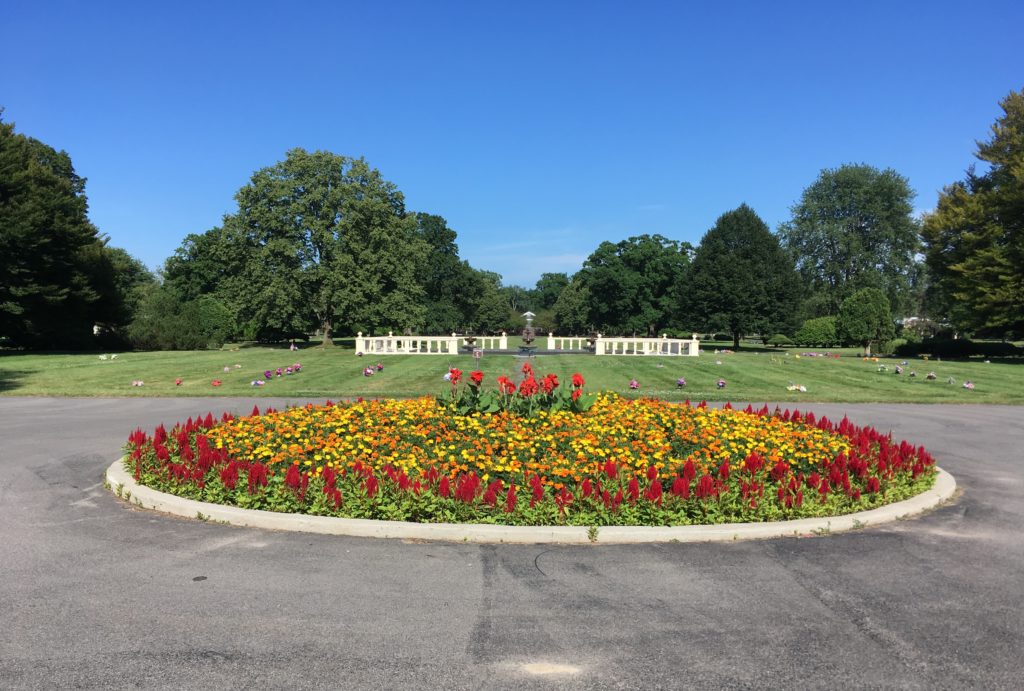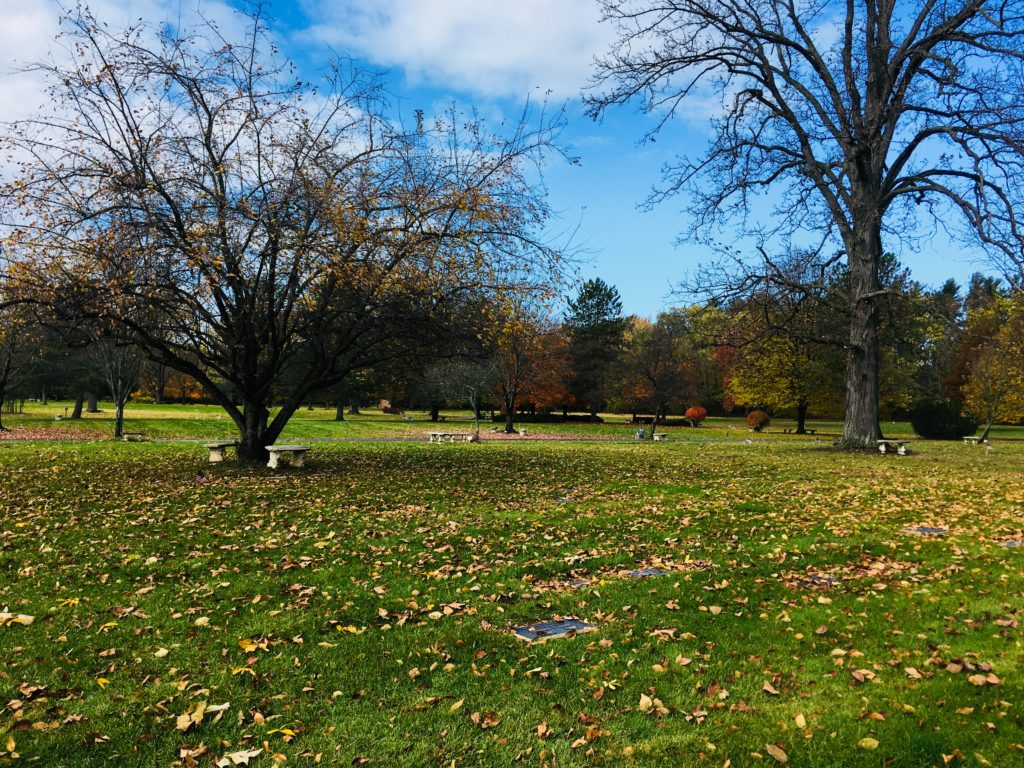While mowing my back yard one day last summer, I got to thinking about cemeteries. And not because our lot backs up to one—or to get technical, a memorial park. It was the mowing that caused it.
 Suddenly the whir of the blade and the smell of the grass carried me back to the summer when our Boy Scout troop took on the task of mowing the cemetery in our small town in southern Arkansas. I would borrow my daddy’s pickup and drive around town loading up boys and their family push mowers, and we would head over to the cemetery and give it a thorough, if uneven, clipping. We never succeeded in getting all the mowers to cut at the same height, but we mowed earnestly and respectfully and cleaned up after ourselves, and I think folks appreciated our efforts even if the aesthetics were a little off.
Suddenly the whir of the blade and the smell of the grass carried me back to the summer when our Boy Scout troop took on the task of mowing the cemetery in our small town in southern Arkansas. I would borrow my daddy’s pickup and drive around town loading up boys and their family push mowers, and we would head over to the cemetery and give it a thorough, if uneven, clipping. We never succeeded in getting all the mowers to cut at the same height, but we mowed earnestly and respectfully and cleaned up after ourselves, and I think folks appreciated our efforts even if the aesthetics were a little off.
We all have loved ones in cemeteries or memorial parks, and we’ll all end up in one someday unless we opt for cremation and having our ashes stored in some other place or scattered somewhere, or God forbid, we perish in some way that precludes recovery of our bodies. Still, cemeteries make some people uncomfortable. And that is understandable. We all have different life experiences, lose loved ones in different circumstances, and grieve in our own personal ways.
Like most people, I have cried at the funerals of friends and loved ones, again as they were interred, and again when visiting their resting places afterward. Yet when I was mowing that afternoon, I suddenly realized that in addition to living next to a  cemetery—or to get technical again, a memorial park—I have spent a lot of time in and around cemeteries over the years. During my parents’ lifetimes I went with them to visit relatives’ graves in cemeteries all over southern Arkansas and northern Louisiana. Later, I accompanied a genealogist friend to many more in search of his ancestors’ burial plots, and I helped him record all the grave makers in some of them for deposit in libraries. Both as a tourist and a historian doing research I have visited historic cemeteries and presidential burial sites all across the country, including Arlington National Cemetery and the cemetery at West Point, and I once wrote a National Historic Landmark study for President William McKinley’s tomb.
cemetery—or to get technical again, a memorial park—I have spent a lot of time in and around cemeteries over the years. During my parents’ lifetimes I went with them to visit relatives’ graves in cemeteries all over southern Arkansas and northern Louisiana. Later, I accompanied a genealogist friend to many more in search of his ancestors’ burial plots, and I helped him record all the grave makers in some of them for deposit in libraries. Both as a tourist and a historian doing research I have visited historic cemeteries and presidential burial sites all across the country, including Arlington National Cemetery and the cemetery at West Point, and I once wrote a National Historic Landmark study for President William McKinley’s tomb.
I’m not alone in most of these kinds of experiences, but I bet that relatively few people share my and my neighbors’ experience of having our yards back up to a nicely landscaped 165-acre memorial park that, for our family anyway, has become a natural and comfortable part of our daily lives.
Almost every day for years, we have seen multiple graveside services and scores of people placing flowers on loved ones’ resting places. We have heard countless military salutes and observed hundreds of vehicular processions, including a large number by motorcycle groups driving slowly through the park single file, their Harleys giving off a chorus of deep, low, almost mournful rumbles that sometimes sound almost as if the heavens are opening up to receive the person for whom the riders are showing respect. There are joggers and dog walkers too. No bicycles are allowed, though.
 And then recently there is the gentleman who comes almost daily in all kinds of weather, pushing his walker to a particular grave site forty yards from our kitchen window then sitting on the folding seat of the walker, sometimes for hours, usually with his head bowed in silent communion, thought, or prayer, or perhaps even a nap. We don’t know him, nor would we ever disturb him, and we don’t know if he is feeling sad, lonely, or thankful for the time he had with whomever he mourns. We just say to each other, “Sebastian,” as we’ve come to call him among ourselves, “is back,” and we count ourselves fortunate to be near such a lovely, unselfconscious, and consistent act of devotion.
And then recently there is the gentleman who comes almost daily in all kinds of weather, pushing his walker to a particular grave site forty yards from our kitchen window then sitting on the folding seat of the walker, sometimes for hours, usually with his head bowed in silent communion, thought, or prayer, or perhaps even a nap. We don’t know him, nor would we ever disturb him, and we don’t know if he is feeling sad, lonely, or thankful for the time he had with whomever he mourns. We just say to each other, “Sebastian,” as we’ve come to call him among ourselves, “is back,” and we count ourselves fortunate to be near such a lovely, unselfconscious, and consistent act of devotion.
Postscript: I wrote the original draft of this post last winter, but at the time I didn’t have a decent spring photograph of the memorial garden. “Sebastian” had never visited during the heart of winter, when usually four or more inches of snow covered the ground, making it impossible for him to cover the distance from the access road to the gravesite. But we expected him back this past spring, and when he didn’t reappear after the snow melted away, I decided to await his return. Now it’s mid-July, and still we have not seen him. We don’t know whether he is ill and unable to visit or has moved to some other part of the country, perhaps to live with a grown child or other relative. If he has now passed from this life himself, there are no new graves in the area to indicate it. In any case, we miss seeing him, we remember him with reverence, and we wish—particularly given the increasing amount of hateful language and behavior our country is experiencing these days—that the world possessed a larger measure of the love and respect he was demonstrating each time we saw him.
To be notified of new posts, please email me.